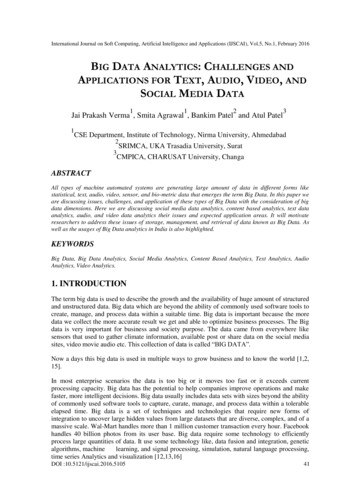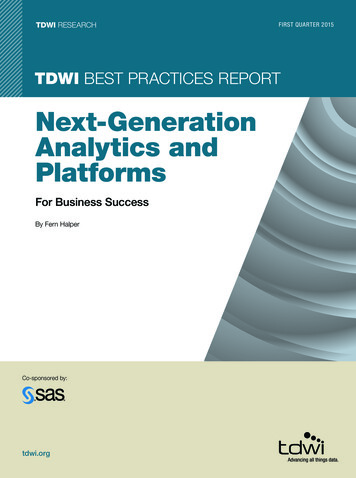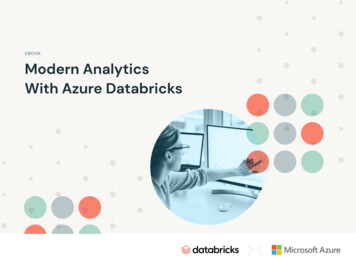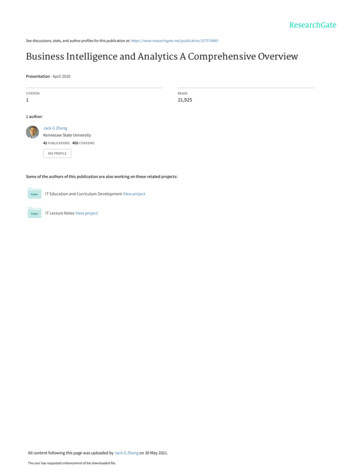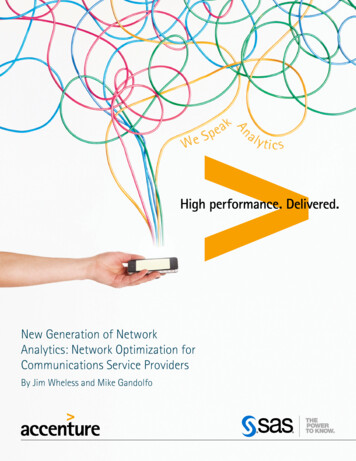
Transcription
New Generation of NetworkAnalytics: Network Optimization forCommunications Service ProvidersBy Jim Wheless and Mike Gandolfo
As demands on today’s networksgrow, the ability of communicationsservice providers to plan andmanage capacity, and to deliversuperior service to customers, isbeing severely challenged. Today’sadvanced analytics capabilities cansupport better capacity planning andtraffic management as well as moreeffective service assurance to delivera customer experience that retainssubscribers and increases revenue.2
How analytics can help improveservice quality and capacityplanningThe telecommunications businessfaces many challenges these days,to be sure. Traditional sources ofrevenue are declining dramatically;the exponential growth in mobiledevices has put strains on networksthat were never built for suchusage and loads; and traditionalways of modeling network trafficand billing for it are no longer equalto the task. These challenges areparticularly intense in the current,disruptive period of convergence,when communications companiesare competing across traditionalindustry boundaries with a broaderarray of companies, many ofwhich have a stronger heritage ofcustomer centricity and were bornin the Internet era.On the positive side, the marketplacepotential of communications providersremains exciting. It is no exaggeration tosay that broadband and mobile networksare the lifeblood of modern society.Revenues based on the movement of thatlifeblood—that is, on network traffic—are increasingly becoming an essentialcomponent of the business model fortoday’s communications companies.This is where a new generation ofnetworks analytics tools and solutionscomes into play, helping communicationsproviders optimize network builds andupgrades, reduce outages, improvethe customer experience, and simplifynetwork control and operations.The problem is that you can’t effectivelymonetize the value of network trafficif you can’t see into the details of thetraffic to know what its value is. You can’timprove and personalize the customerexperience you’re delivering unless youhave sufficient information about thequality of experience across the broadernetwork delivery system. And you can’tdirect investments properly in deploying4G unless you can be more confidentabout where the revenues are or will becoming from. When it comes to driving anew era of growth in telecommunications,knowledge really is power.3
Network analyticsImproving the customer experience and optimizingnetwork investmentsInnovations and developmentsin the area of networkanalytics can be understoodas driving improvements inthree areas especially critical tocommunications service providers.1. Network control andoptimization3. Network capacityplanning and deploymentAnalytics tools can improve networkmanagement by more effectivelyfactoring in issues related to congestion,such as utilization, service consumptionand routing. Perhaps more important,such tools can provide real-time insightsinto network traffic to determine thevalue of different portions of that traffic.Those capabilities can help facilitiesbased operators direct network changesand investments to target specific, highlyprofitable services and applications,helping to optimize the commercial valueof available and incremental bandwidth.Network analytics tools can transcendthe limitations of traditional trafficforecasting approaches such as minutesof use and data volumes. Newer statisticalmodels integrate simulation techniquesand can link demands for a certain qualityof service to network specificationsfor each cell in a defined geography.By anticipating network bottlenecks ina more granular way and with betteraccuracy, communications providers canplan network expansions properly andwith more precision—something that canimprove the provision and utilization ofcapital expenses by five percent or more.2. Network serviceassuranceNewer analytics capabilities enablecompanies to move beyond older waysof managing service availability—approaches based on peak performancemonitoring. Network analytics enablesa communications provider to optimizecustomers’ quality of experience byassessing all the relevant historicalnetwork data over a continuous timeline(by day or week, or by seasonal behaviors)to distribute bandwidth where it is mostneeded and to manage user experiencesmore effectively. Better service assurancecan increase network efficiency by10 percent or more while maintaininga high quality of experience. Morebroadly, analytics can use network eventcorrelation to help communicationsproviders understand how equipment,devices and bandwidth consumptionare affecting the customer experience—helping companies take steps to improvethat experience.4Part of an overall “journey to analyticsROI,” these capabilities help strengthenthe alignment of network capabilitiesto a communications provider’s overallbusiness, increasing revenues, reducingexpenses and potentially improvingnetwork ROI by up to 15 percent.The following sections look at these threeimportant areas of network analytics inmore detail.
Today’s advanced network analytics solutions can help communications service providers dramatically improve their capabilities innetwork optimization, service assurance and capacity planning.Network Control& OptimizationAnalyticsNetworkService AssuranceAnalyticsNetworkCapacity Planning &Deployment AnalyticsEnable network control factoringin congestion, routing, andscheduling to optimize resourceallocation and reduce OPEXUse network event correlation tounderstand how equipment,devices and links affect thecustomer experienceProvide accurate forecasts oftraffic volume and congestion toaid network planners in makingthe best CAPEX investments fornetwork capacityMarketingEngineering Quality && Planning OperationsPortal (Business Views)Portal (Business Views)Analysis &ReportingServiceO&MBatch and Online ProcessingBatch ETLEngineering Quality && Planning OperationsRealTimeEngineOnline CPEAnalysis &ReportingServiceO&MBatch and Online ProcessingBatch ETLOnline CPEMarketingEngineering& PlanningPortal (Business Views)RealTimeEngineAnalysis &ReportingServiceO&MBatch and Online ProcessingBatch ETLRealTimeEngineOnline CPECopyright 2013 Accenture. All rights reserved.5
Network control and optimizationMoving beyond “all you can eat”Traffic volumes across today’snetworks have increaseddramatically in recent years, andwill continue to do so, but manycommunications service providersare not fully capable of chargingcustomers based on the valueof the data going through thosepipes because they have no realtime capabilities to analyze trafficat a sufficiently granular level.Companies know that “all youcan eat” data plans are no longertenable if they are to drive a newera of growth, but they need helpmoving to a new billing modelbased on the ability to identify thevalue of particular parts of theirnetwork traffic.6From a technical perspective, thismeans that many companies’ networkdimensioning capabilities are deficientin how they support today’s distinctivedata traffic environment. Whennetworks carried mostly voice traffic,using counters was the way companiesperformed network dimensioning. It wasrelatively simple given the generally oneto-one relationship between resource andservice. All you had to do was measurea single-threaded service on a fixedpoint-to-point communication channel.You could even set it up in a commonspreadsheet software program and readilytrack your network load.In today’s traffic environment, what’sneeded is continuous dimensioningdown to the cell, managing to particularquality-of-experience targets for eachInternet Protocol (IP) multimedia service.Consider the experience of a largenetwork operator and service provider inthe Asia Pacific region. The company hadmultiple networks including fixed, wirelessand broadband. With such a complexnetwork environment it was difficult tointegrate data to get proper visibility andmanage traffic while keeping costs inline. It could only react to problems afterthey occurred because it did not have theability to anticipate performance issues.A network analytics capabilityestablished by the provider has nowcreated a unique network managementenvironment capturing utilization andother performance data across morethan 93 multi-standard and multitechnology products supporting theOSS infrastructure. Traffic data isavailable in near-real-time for assessingthe performance of critical networkmanagement processes. The provider canmonitor congestion spots and re-routetraffic for maximum throughput.
Driving greater business value from new network analytics approachesAcross multiple capabilities—fromforecasting to dimensioning tobudgeting and planning—networkanalytics delivers more robustand accurate information tocommunications service providerscompared to their legacy approachhelping them realize greaterbusiness value.Legacy ApproachNetwork Analytics ApproachTrafficForecasting Singular forecasting based on minutes of use /data volumes (Erlang theory) Threshold-based planning Per-cell statistical model Forecast joins network load, device, application anduse behaviorNetworkDimensioning Independent service Voice: Erlang / peak-based Data resources dimensioned based on best-effortassumption Per-cell dimensioning Continuous dimensioning Managing to quality-of-experience targets for eachIP multimedia serviceOperational andCapital ExpenseManagement Broad-based expenditure estimates- Average load per cell- Average minutes of use Disparate, manual processes Integrated analysis (voice, data, cost, etc.) Centered on quality of experience: Service, value,budget estimation per cellNetworkUtilizationValue Macro two-dimensional- Per minute- Per byte Detailed and multi-dimensional- Per minute/ event / byte / service- Per geography/ customer segment- Per time of day / type of dayReturn-onInvestmentOptimization Budget allocation based on available capacity forcongested cells Clustering and prioritizing capacity and qualityupgrades to improve ROICopyright 2013 Accenture. All rights reserved.7
Network service assuranceOptimizing the quality of experience and providingtimely customer insightsFor many communicationsservice providers, the exponentialgrowth in network elements,service platforms and connecteddevices means that the expandingvariety and volume of networkdata services are overwhelmingthe company’s ability to providehigh-quality service assurance—asituation that can damagecustomer relationships. With dataservices taking an ever-increasingshare of the utilization of thenetwork, companies need to beable to proactively monitor networkperformance and provide real-timecorrelation or root-cause analysisto help isolate faults.Today’s network analytics solutions enableproviders to correlate network issuesto service quality and service impacts.They can more readily understand howequipment, devices and links enhance thecustomer experience through networkevent correlation.Real-time service modeling enablesimmediate geographical views of servicestatus, with drill-down functionalitiesintegrating all network components in theservice model. Real-time feedback canalso allow for the sourcing and integrationof customer profiles based on location,service usage and socio-demographicinformation, and can trigger appropriatecorrective action.For example, a European communicationsservice provider is using an analyticssolution to monitor service provisioningand anticipate anomalies in networktraffic. The company provides its serviceson a distributed network throughoutthe entire country, which requiressophisticated analytics to monitornetwork traffic and service performance,anticipate evolutionary trends and preventanomalies.The solution enables this provider toanalyze historical trends in networktraffic related to client usage and monitorservice provision performance. Thecompany can anticipate the evolutionof traffic in real time and can also applyforecasting models to predict the trafficanticipated during an upcoming periodof time based on historical data frompreceding periods. This enables them toassess the deviations compared to a saferange of expected values and enable theappropriate checks.8The ability to detect anomalies in serviceprovisioning and proactively evaluatedeviations compared to anticipatedtraffic is very important when it comesto network operations. According to aservice manager at this European provider,“Given the complexity of the networkand the branching of the distributedservers involved in the services, it iscritical to gain a detailed insight of theservice usage trend as well as anticipateany discontinuity due to either internalissues or to an external service provider.Analyzing usage trends helps us beprepared to quickly respond when weget generic notifications that don’t tellus what the specific network problem is.We can also evaluate the impact that aneffective failure, for example in a singleaccess node, can have on national trafficvolumes.”Delivering customer insightsto the sales and marketingorganizationAnother benefit of advanced networkanalytics is in using accurate customerdata to generate insights that can helpthe sales and marketing organizationtarget customers with more relevantoffers. For example, one North Americanmulti-play provider was challenged at thebeginning of the most recent economicdownturn because of stiff competitionfrom cable operators and new IP-basedentrants. The company knew that thata complete turnaround of its sales andmarketing efforts was needed.
Collaborating with Accenture and SAS,the provider developed a strategy totarget different customer needs with newsolutions. At the time, too few customerswere being actively managed; channelcoverage overlapped and lead listswere inaccurate. To counter aggressivecompetition and achieve growth, theprovider needed deeper customer insightand targeting along with better channelalignment and development.With improved network analyticscapabilities from Accenture and SAS,the provider was able to redefine themedium-business customer in less thanthree months by aggregating a variety ofexternal and internal data sources into a360-degree view of the customer acrossthe entire portfolio.Armed with this 360-degree view, theprovider could statistically segment itsmainstream and premium customersinto micro segments, grouping variousbusinesses in new ways to produceinsights. This segmentation enabledthe provider to determine the rightchannel treatment and solutions for eachcustomer grouping. Today, the companycan tailor solutions, bundles and offersthat are sized appropriately, have theright price-to-value proposition and areserviced by the appropriate channel.The new approach enabled the providerto understand who its medium-businesscustomers were well beyond their industrycodes—providing a complete customercentric view. That view could help theprovider answer questions like: Whereis the customer located, including itsheadquarters and branch offices? What isthe customer’s corporate structure? Howmany employees? How much and whattype of services are in use across voice,data, IP and managed services?9
Network capability planningProviding solid forecasts to optimize investmentsCommunications service providersare investing billions of dollars innetwork upgrades and build-outsas 3G and 4G networks becomethe norm in the industry. Yet toofew such companies have thedetailed information they need toguide those investments properly.Engineering-based thresholdingapproaches are still mostly thenorm, but these approaches arenot equal to the challenge ofperforming network planning inthe current business, customer andtechnology environment.to meet customers’ demands for newproducts and services and to introducenew feature sets as quickly as possible.Although the company needed to providethat bandwidth so it could offer newproducts and services to customers, thequestion for this provider was how to gainthe information it needed to properly directits spending so that investments did notget tied up in services that did not generatesufficient revenues.Threshold-based planning was developedin a simpler era in which one could monitornetwork resources and issue a purchaseorder for a capacity upgrade in case acertain threshold was breached. What’sneeded instead are advanced forecastingtechnologies that combine granularperformance data—down to the cell level—with device, application and usage datafor greater precision in managing networkupgrades while maintaining a satisfactoryquality of experience.The provider’s new SAS-based analyticssolution is a straightforward, simplersolution that offers the statistical rigorrequired to do heavy-duty marketanalysis. Previously, the company couldonly factor in one or two variables inThe potential revenue of each cell can beestimated by mapping current congestionof the cell (an indication of its usage andtherefore its importance to customers)against current costs. (See Figure 1.)By correlating the usage data withfinancial information, network analyticscan generate insights that can help acommunications provider determine howmuch to invest in particular cells basedon maximizing revenue over cost whilesimultaneously complying with budgetconstraints.An example of an effective forecastingsolution comes from a North Americanmulti-play provider which was challenged10its analysis, such as a supply-demandscenario or marketing forecast. With itsnew multivariable solution, the companycan generate a more realistic forecastthat factors in other variables includinggross domestic product (GDP) indicators,technology trends, population trends,network utilization statistics and even socalled disruptive trends such as a regulatorychange or a new-product announcementthat can change the telecom market almostovernight. These multi-variables providethe data needed to back up forecasts andto make the right type of predictions forplanning on capital and operating expenses.The company’s existing forecastingapproach was highly dependent onspreadsheets and a PC-based database, asituation that often caused non-integratedand inconsistent data to be fed intoplanning cycles.This analytics solution is also enabling aconcept the company calls “just-in-timeinvestments” – the capability to investdollars at the right place at the righttime. The analytics team helps area vicepresidents plan their operating and capitalexpenses based on network readiness intheir specific areas and on order volumes,making sure that delivery times can be met.Figure 1: Network analytics can generate insights about which cells should receive budgetallocations based on maximizing revenue over cost.Cell Potential Revenue12001000 10K 20K800 50KCost 50K600 10K400 20K 15K200 25K 10K0%20%40%60%CongestionRepresentative numbers and clustering are for illustrative purposes only.Copyright 2013 Accenture and SAS. All rights reserved. 15K80%100%
ConclusionThe analytics journey to ROIAs increasing numbers ofcommunications service providersare discovering, network analyticsis a means to transform the abilityto provide cost-effective service,deliver differentiated qualityto customers and plan for thenext generation of networks andservices.Analytics is an important accelerator in theera of convergence and a significant growthopportunity for these companies, helpingthem out-innovate and out-execute an everexpanding list of competitors.Using analytics to improve the customerexperience and deliver solid returns oninvestment is in most cases a longer-termjourney (see Figure 2), but one that canproceed rapidly as companies develop theability to unlock the value of big data, andthen apply a broad spectrum of analytics-based assets and market-tested approachesto generate actionable insights.As insights are integrated into decisions andprocesses, communications service providersgain the ability to take action faster and inthe right areas. They can take proactive stepsto deliver high-quality services to customersand to keep network capacity ready so theycan improve customer loyalty and drivegrowth from the exciting communicationsproducts, services and applications beingcreated almost every day.Figure 2: The journey to greater ROI begins by identifying critical business issues. Analytics is then used to unlock the value of data inorder to generate the insights needed to take action.The Analytics Journey to ROIShrinking market sharePricingpressuresCustomer defectionFragmentation andcomplexityInefficient operationsAged platforms andsystemsExpanding market shareWhat?What?Gaining insightsfrom enormousamounts of diversedata.How?We combinetechnical andbusiness expertiseto unlock the valuefrom big data usingadvanced analyticsplatforms, opensource technologiesand a strongalliances network.Employee engagementFraud & non-complianceCopyright 2013 Accenture. All rights reserved.What?Driving insightsdiscovery throughthe rightcombination ofquantitativetechniques,analytical talentand newtechnologies.How?Our globalnetwork ofanalytics expertsapply a broadspectrum ofanalytics-basedassets andmarket-testedapproaches to findand createopportunities forsignificant impact.Generatingactionable insightsto drive improvedcustomeracquisition,retention andcapitalefficiency.How?We have a highlyrelevant portfolioof issue-basedindustry andfunction solutionsto drive insightdriven businessoutcomes.Enhanced cost andcash advantageWhat?This is the momentof truth – makingthe leap toadoption as insightsare integrated intoour decisions andprocesses.How?Our analytics expertsdeploy newprograms, tools andprocesses, turninginsights into actionsand drivingoutcomes at scale.Customer loyaltySpeed-to-insightsOperational excellenceLeading edge platformsand systemsWinning the warfor talentReduced risk and fraud11
About the authorsJim Wheless leads the analytics practicefor Accenture Communications, Media andTechnology. He can be reached atjim.wheless@accenture.com.Mike Gandolfo is a market developmentexecutive in the communications industryfor the SAS Institute and can be reached atmike.gandolfo@sas.com.About Accenture and SASWorking together, Accenture and SASenable organizations to use the power ofanalytics to seize growth opportunities, getprecise answers to complex problems, andspeed innovation and decision making.Hundreds of companies have benefitedfrom Accenture’s business analyticssolutions, powered by SAS’ pioneeringanalytics. Companies are encouragedto visit Accenture Customer Showcaseand Innovation Centers worldwide to seedemonstrations of SAS analytics in realworld scenarios. Our strategic alliancehelps clients in all industries includingfinancial services, high tech and the publicsector anticipate disruptive market andoperational events, and improve businessperformance at lower cost.About AccentureCommunications IndustryGroupThe Accenture Communications IndustryGroup serves leading communicationsservice providers in an increasingly evolvingand dynamic competitive environment.Accenture helps Communications industryclients meet the challenges to connect withthe digital consumer, increase revenues,develop and launch innovative productsand services quickly and optimize networkperformance while reducing costs. Thecombination of our consulting, technologyand outsourcing experience, paired with ourdeep industry knowledge, helps us bring theright solutions and resources to enable ourclients to unlock profitable growth, improveoperations and achieve high performance.To learn more about how Accenturetransforms analytics into actionwith SAS, visit www.accenture.com/analyticsalliances-sas.Copyright 2013 AccentureAll rights reserved.Accenture, its logo, andHigh Performance Deliveredare trademarks of Accenture.SAS and all other SAS Institute Inc. product or servicenames are registered trademarks or trademarks ofSAS Institute Inc. in the USA and other countries. indicates USA registration. Other brand and productnames are trademarks of their respective companies.Copyright 2013 SAS Institute Inc. All rights reserved.The use herein of trademarks that may be ownedby others is not an assertion of ownership of suchtrademarks by Accenture nor intended to imply anassociation between Accenture and the lawful ownersof such trademarks.The views and opinions in this article should not beviewed as professional advice with respect to yourbusiness.13-1287U/ 9-4682
network investments Innovations and developments in the area of network analytics can be understood as driving improvements in three areas especially critical to communications service providers. 1. Network control and optimization Analytics tools can improve network management by more effectively factoring in issues related to congestion,

